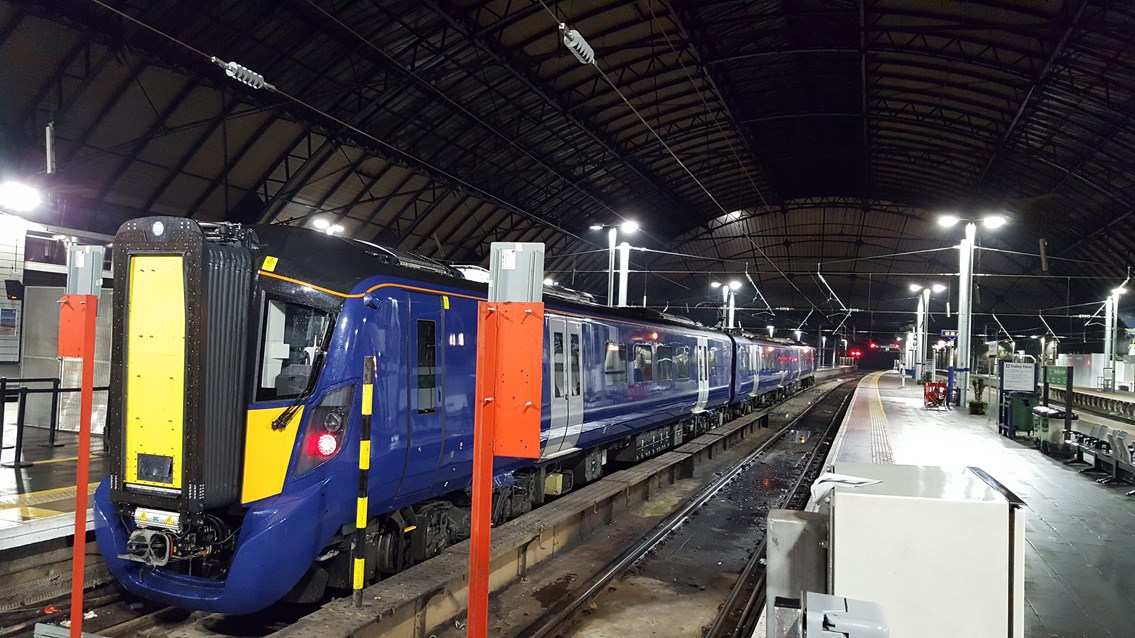Friday 3 Nov 2017
EGIP update - first electric train runs full Edinburgh-Glasgow line
- Region & Route:
- Scotland’s Railway: Scotland
The Edinburgh Glasgow Improvement Programme (EGIP) reached another milestone this week with the first electric train running end-to-end on the main Edinburgh-Glasgow line.
Successfully running the first electric train on the line is the culmination of a project which has been a decade in the planning and four years in delivery to upgrade Scotland’s busiest inter-city rail route.
One of the new Hitachi Class 385 electric trains travelled between Edinburgh Waverley and Glasgow Queen Street overnight on Tuesday, October 31, into Wednesday, November 1.
Representing the biggest transformation of the route its 140-year history, the electrification of 46 miles of railway between Edinburgh and Glasgow, via Falkirk High, marks an important milestone in the delivery of the overall EGIP.
A central part of the Scottish Government’s rail strategy, EGIP delivers a 20% reduction in journey times and adds 30% more capacity, on comfortable, efficient and more reliable electric trains.
Kevin McClelland, route delivery director for infrastructure projects, said: “I’m delighted that the first Class 385 electric test trains ran between Newbridge and Queen Street on the newly electrified route from Edinburgh to Glasgow.
“The achievement of running the route end-to-end is a momentous day for everyone connected with EGIP over the past few years. It is the culmination of years of hard work, dedication and commitment from across the team which has been invested in the project to make this happen.
“While we acknowledge that delivering a project of this scale to electrify a live railway has not been without its challenges, the experience and learning we have taken from this stands us in good stead to deliver more of the rolling programme of electrification that continues across central Scotland.”
During the delivery of EGIP engineers have demolished and rebuilt 60 structures across central Scotland over a four year period to create the extra height needed to safely run the overhead electric cables. In addition, 100 bridges also had their parapet (side wall) heights raised to comply with new safety standards and help keep the public at a safe distance from the overhead equipment.
Platforms were also extended at a number of stations including Croy, Falkirk High, Polmont and Linlithgow and extensive work was required in Winchburgh and Queen Street tunnels to create the correct clearances for electrification.
Across the project 30,000m3 of concrete was poured and nearly 3,000 piled foundations were sunk to provide the bases for the 4,600 tonnes of steel masts that have been erected to carry the 616 kilometres of wires that have been installed on the route.
Almost 4,000 people have contributed to the delivery of the project working a total of almost 6 million staff hours.
Contact information
Passengers / community members
Network Rail national helpline
03457 11 41 41
Latest travel advice
Please visit National Rail Enquiries
Journalists
Network Rail press office - Nick King
Media relations manager (Scotland)
0141 555 4108 / 07515 617073
nick.king3@networkrail.co.uk
About Network Rail
We own, operate and develop Britain's railway infrastructure; that's 20,000 miles of track, 30,000 bridges, tunnels and viaducts and the thousands of signals, level crossings and stations. We run 20 of the UK's largest stations while all the others, over 2,500, are run by the country's train operating companies.
Usually, there are almost five million journeys made in the UK and over 600 freight trains run on the network. People depend on Britain's railway for their daily commute, to visit friends and loved ones and to get them home safe every day. Our role is to deliver a safe and reliable railway, so we carefully manage and deliver thousands of projects every year that form part of the multi-billion pound Railway Upgrade Plan, to grow and expand the nation's railway network to respond to the tremendous growth and demand the railway has experienced - a doubling of passenger journeys over the past 20 years.
Follow us on Twitter: @networkrail
Visit our online newsroom: www.networkrailmediacentre.co.uk

